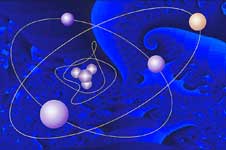The international system of units (SI units) has 3 primary units and a number of secondary units. Other quantities such as the joule, newton... can be defined by different combinations of these units as described on the standards page.
Primary Units
| unit | of | definition | |
|---|---|---|---|
| Second | s | Time | The time equal to the duration of 9,192,631,770 periods of the radiation corresponding to the transition between two hyperfine levels of the ground state of the caesium-133 atom. |
| Metre | m | Length | The length of the path travelled by light in a vacuum during a time interval of 1/299,792,458 of a second. |
| kilogram | kg | Mass | The mass of the international prototype kept in Sèvres, France. It is proposed that this is changed such that the Plank constant is exactly 6.6260693×10-34 joule seconds. |
Is it nesessary to have 3 units? We could relate distance and time by the speed of light which is a physical constant. So for example distance could be measured in seconds. One second would be the distance it
takes light to go in a second (similar to a light-year). We would then only
need two units: seconds and kg.
So instead of the hard to remember equation:
E = m c^2
we would have the much simpler:
E = m
This idea for a system of units where c=1 is mentioned in The Feynman lectures on Physics, book 1, 17-3.
Another question is whether Newtons (force) is more fundamental than kg (mass)?
Secondary Units
| unit | of | current definition | proposed definition | |
|---|---|---|---|---|
| ampere | A | Current | The current which, if maintained in two straight parallel conductors of infinite length, of negligible circular cross-section, and placed 1 metre apart in a vacuum would produce between these conductors a force equal to 2 ×10-7newtons per metre of length. | The ampere is such that the elementary charge is exactly 1.60217653×10-19 coulombs (1 coulomb = 1 ampere second) |
| kelvin | K | Temperature | The fraction 1/273.16 of the thermodynamic temerature of the triple point of water. | The kelvin is such that the Bolzmann constant is exactly 1.3806505×10-23 joules per kelvin. |
| mole | mol | Amount of substance | The amount of substance that contains as many elementary units as there are atoms in 0.012 kilograms of carbon-12. | The mole is such that the Avogadro constant is exactly 6.0221415 ×1023 per mole. |
| candela | cd | Luminous intensity | The intensity, in a given direction, of a light souce that emits monochromatic radiation of frequency 540 ×1012 hertz with a radiant intensity in that direction of 1/683 watts per steradian. | unchanged |


